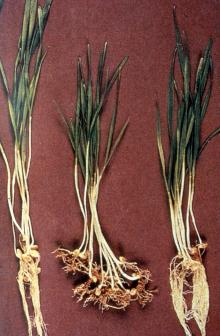Cause The cereal cyst nematodes, Heterodera avenae and H. filipjevi, occur in at least seven Western States including Idaho, Washington, Oregon, and California. This nematode has a wide host range in the Gramineae including oats, wheat, barley, rye, triticale and ryegrass. Susceptible spring grains are barley, oats, wheat, rye, and triticale. Spring varieties are more severely affected than fall varieties because the nematode attacks in spring when plants are small. Only a small number of resistant spring wheat and spring barley varieties have been identified. Wheat and barley varieties differ in ability to tolerate invasion by these nematodes. Yields of intolerant varieties decline as the number of nematodes in soil increase. Yields of tolerant varieties remain relatively stable even when the population of cereal cyst nematodes is high. Several tolerant varieties of spring wheat and spring barley have been identified.
Cyst nematodes are sedentary endoparasites. The infective second-stage juvenile is generally at low levels in soil except during egg hatch in spring. Males may be in soil in late summer. Cysts (the dead body of the female, which holds eggs and allows eggs and juveniles to survive between host crops) can be obtained from soil any time, but cyst extraction requires a special procedure. This nematode can only reproduce on roots of living susceptible hosts. The nematode only invades juvenile tissue at root tips, hence the greater susceptibility of spring-planted crops. The nematode has different pathotypes (races), each of which attack a different set of hosts. In Oregon, wheat varieties with the resistance gene Cre1 prevent reproduction of H. avenae but not H. filipjevi. Barley with the resistance genes Ha2 or Ha3 also prevents multiplication of H. avenae.
Symptoms Plants in small to large patches, or larger areas up to several acres or entire fields are stunted and chlorotic. Symptoms are expressed more fully when mineral nutrition is limiting or root growth is otherwise impeded. In the field, the symptoms of cereal cyst nematode injury were first mistaken for barley yellow dwarf virus. Roots are locally thickened and highly branched. Before harvest, white females can be seen attached to roots, appearing as one to several small white beads near areas of excessive root branching. Later, females become brown to black cysts, which are difficult to see without magnification.
Sampling If a cyst count is desired, note that on the form accompanying the sample. During the growing season, it is helpful to send roots as well as soil to assist the diagnosis.
Cultural control
- Crop rotation. Avoid planting susceptible cereal (wheat, barley, oat) or grass crops successively or in close rotation. Rotate cereal crops with broadleaf (nonsusceptible) crops, corn, or resistant cereal varieties.
- Identify the species of cereal cyst nematode because wheat varieties differ in their response to attack by H. avenae and H. filipjevi.
- Fall-planted crops can tolerate damage by this nematode more than spring-planted crops. Within the spring cereal varieties, the 6-row feed and malting barleys have been collectively more resistant than the 2-row feed barleys, 2-row malting barleys, soft white wheats as well as the hard red and hard white wheats. In contrast, the 2-row feed and malting barleys were collectively more tolerant than entries in the other spring cereals classes.
- No spring wheat varieties are both fully tolerant and fully resistant to H. avenae. Varieties that are resistant and moderately tolerant include Dayn and WB Rockland. Varieties with a balance of partial resistance plus partial tolerance include Kelse and Klasic. Tolerant but susceptible spring wheat varieties include Alpowa, Buck Pronto, Cabernet, Glee, JD, Jedd, Jefferson, Louise, UI Petit, and UI Stone. While the variety WB Rockland is resistant and moderately tolerant to H. avenae, it is not resistant to H. filipjevi. In contrast, the variety SY Steelhead is resistant to H. filipjevi and is tolerant but not resistant to H. avenae.
- Lenetah spring barley is both resistant and tolerant to H. avenae. Varieties that have acceptable levels of both resistance and tolerance include Julie, Baronesse, Champion, Xena, Idagold II, Transit, Millenium, and Quest. Varieties that are very tolerant but quite susceptible in allowing nematode reproduction include Tetonia, Vespa, Copeland, Merit, Merit 57, Pinnacle, and Herald. Varieties that are partially resistant but lack acceptable levels of tolerance include Goldeneye, Legacy, Steptoe, Tradition, Celebration, Odyssey, and CDC Fibar.
- Assure adequate fertility for vigorous growth of the crop.
- Avoid movement of soil from infested fields.
- Identify the species of cereal cyst nematode because crop varieties may differ in their response to attack by H. avenae and H. filipjevi.
Chemical control
- No effective chemicals are registered.
- Soil fumigation is too expensive for dryland cereal crops, but in irrigated agriculture it can be used in a rotation with a higher-value crop such as potato.
References Smiley, R.W., Ingham, R.E., Uddin, W., and Cook, G.H. 1994. Crop sequences for managing cereal cyst nematode and fungal pathogens of winter wheat. Plant Disease 78:1142-1149.
Smiley, R.W., Yan, G., and Pinkerton, J.N. 2011. Resistance of wheat, barley and oat to Heterodera avenae in the Pacific Northwest USA. Nematology 13:539-552.
Smiley, R.W., and Yan, G. 2010. Cereal Cyst Nematodes. PNW Extension Bulletin 620.
Smiley, R.W. and 10 other authors. 2013. Spring wheat tolerance and resistance to Heterodera avenae in the Pacific Northwest. Plant Disease 97:590-600.
Smiley, R.W. 2014. Cereal cyst nematodes in the Pacific Northwest. Washington State Univ. Extension Bulletin TB01.


